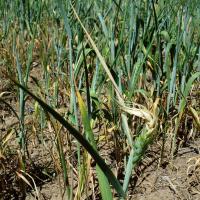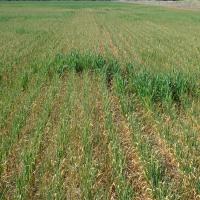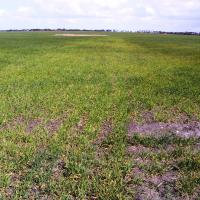Diagnosing spring drought in wheat and barley
Spring drought refers to plant water stress from insufficient rainfall or stored soil moisture occurring between tillering to maturity.
What to look for
- Large areas of stressed or dying plants with some better plants in water gaining areas.
- Low water holding soils, such as coarse sands and gravels, very shallow soil over rock or impermeable layer are more affected.
- Heavy clays that retain moisture near the soil surface after light rainfall where it is more likely to evaporate.
- Areas within the root zone of trees.
- Can be seen in double sown areas or areas of vigorous plants.
Paddock
- Shorter plants.
- Older leaf wilting and becoming dull.
- Young leaves furled and spiky.
- Oldest leaf tipping and death that progresses to other leaves.
- Rat-tailed or sterile heads.
- Shrivelled grain.
Plant
What else could it be
| Condition | Similarities | Differences |
|---|---|---|
|
Soil acidity, boron toxicity, hostile clay loam to clay subsoil and waterlogging
|
Early plant death and shrivelled grain | Causes can be determined by rainfall records, soil type and location |
| Diagnosing stem and head frost damage in cereals | White or rat-tailed head, shrivelled grain | Frost plants are not water stressed, and are more landscape dependent |
| Diagnosing copper deficiency in wheat | White or rat-tailed head, shrivelled grain | Youngest leaves are affected and maturity is delayed with copper deficiency |
| Diagnosing molybdenum deficiency in cereals | Water stressed plants with white or rat-tailed head, shrivelled grain | Molybdenum deficient plants symptoms are more scattered and maturity is delayed |
How can it be monitored?
- Unless the problem is obviously due to drought, dig a hole and examine the soil profile for: Soil pH.
- Presence of restricting layers.
- Soil texture.
Page last updated: Monday, 22 June 2015 - 4:46pm





